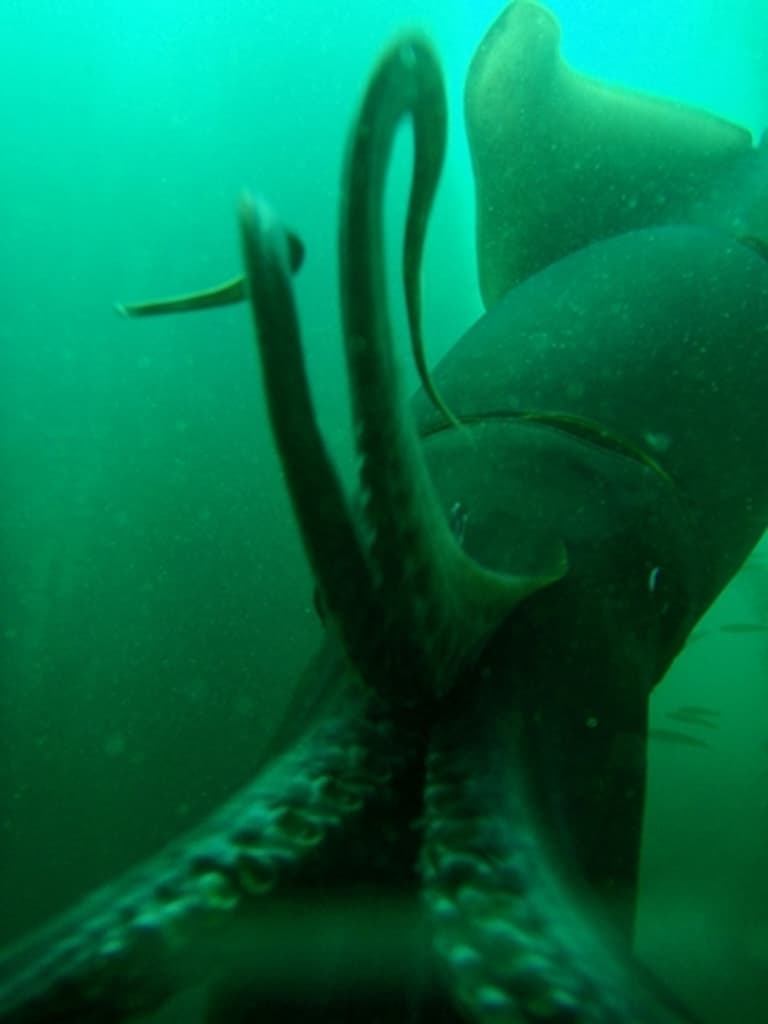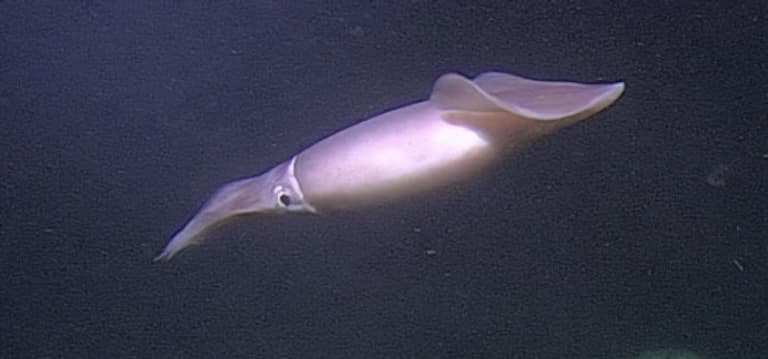Humboldt Squid Profile
The ocean is teeming with nightmare fuel. As humans, even the most accomplished of our freedivers and swimmers are utterly defenceless against many of the specialised and prehistoric killers and maulers out there.
But while the mainstream fears are focused on great white sharks and jellyfish, there’s something far more intimidating to worry about that doesn’t get a lot of attention.
The Humboldt squid is a ferocious alien predator with frightening intelligence, ten suckered arms and an immensely powerful and cutting beak. And it hunts in packs.

Humboldt Squid Facts Overview
| Habitat: | Cold water from 200m to 700m deep |
| Location: | Eastern Pacific |
| Lifespan: | Up to 2 years, often just 1 |
| Size: | Ofteh more than 2 metres (6.5 ft) in total length. |
| Weight: | Up to 50kg (110 lb) |
| Colour: | White to red, able to change between the two |
| Diet: | Copepods as juveniles, larger pelagic fish prey as adults |
| Predators: | Sperm whales, seals, swordfish, sharks |
| Top Speed: | 24 km/h (15 mph) |
| No. of Species: | 1 |
| Conservation Status: | Data Deficient (IUCN) |
Humboldts are terrifying, huge, intelligent and tactical predators of the deep.
They are powerful, with complex brains and a mystery language, and while they mostly feed on fish, they have had a nibble on a diver or two on occasion.
But most interactions with divers are eventless, and perhaps these ancient giants have a lot more to offer us than just fear.
Unfortunately, they are elusive and not well understood, and while they’re brought up by the fishing industry in alarming proportions, very little is known about what they do and how they do it.
Interesting Humboldt Squid Facts
1. They’re flying squid
Humboldt squid are a member of the Ommastrephidae family. This family is characterised by being exclusively predatory, having double rows of suckers on their tentacles and being able to fly.
This isn’t the same kind of “flying” that gets thrown around whenever an animal has evolved to control a fall for a while, but actual, self-propelled flying.
So, not only are they the perfect killing machine, but they can even move through air, for short distances, at least.
Thankfully this behaviour is mostly seen in juveniles, and is a way of escaping predation while they’re still small enough to be trifled with. And thankfully, the adults prefer far deeper waters, below the photic zone, where they can hunt in the dark. 1

2. They grow fast
Being a small squid in a big ocean is asking for trouble, so these animals grow as fast as they can out of sheer panic.
They only get one shot at reproduction and usually only live for a year, so they have to make the best of it. Adults mate fact-to-face, in a terrifying embrace during which males will pass sperm packets into the female’s mouth.
There’s likely a complex courtship ritual involved, but nobody has survived seeing it, so it remains a bit of a mystery.
Eggs mature in around a week, and as soon as they hatch, the little squidlets get to work. This species has the fastest development of any species in the genus, and explodes in size over the first month and a half, growing from 1mm to around 10 mm in the first 50 days or so. 2
3. They have massive balls
By the time they’re mature, the mantle, which may be 1.5 metres long, makes up just over half of the squid’s length.
The head adds another 10% or so, and the tentacles up to 15% on top of that. But in terms of mass, the gonads are fascinating. In extreme cases, they can be up to 15% of the total mass of the squid.
This might explain how they are able to brave being around one another in the cold, dark water.
4. They’re social
These squid are more than just cold-blooded killers. They are likely very intelligent animals. They have large brains and eyes and can change colour rapidly. All of this suggests a potential for social interaction, and Humboldt squid are known to gather in groups of up to 1200 individuals.
When around other squid, they can flash 4 times per second, flickering between red and white all over. They can change the frequency and amplitude of these flashes and often synchronise with one another, displaying an entirely alien form of communication.
What they’re saying, and how complex this language really is remains unknown, but there’s reason to assume that these animals are organised. This is the first invertebrate species that has been witnessed hunting cooperatively.
5. They’re ruthless
These squid use an organ called a hyponome, a siphon, through which the concentrate pressurised water to create thrust.
Coupled with two large and mobile fins, they can propel themselves through the water at up to 24 km/h. When hunting, they employ two tentacles, each with up to 200 suckers, and each of these lined with razor-sharp teeth.
Tentacles are accompanied by eight more, shorter arms, lined with hooked suckers and all of these work to pull prey toward a muscular, sharp beak.
Their most common prey items are fish, but this is a squid with a reputation for taking on larger trespassers, too. 3
6. They can attack people
Off the coast of Mexico, these animals are referred to as Red Devils and have an almost mythological status.
Numerous accounts of people being attacked by Humboldts have been verified, and they’re thought of as aggressive and potentially very dangerous creatures.
But research and experiences suggest that this aggression relates to a feeding frenzy, and isn’t their default state, though some of the stories that divers come back with can be terrifying.
While many divers report a timid curiosity, one story tells of squid trying to open the latch on a diving cage to get to the people inside, and researchers have had their cameras violently attacked.
7. They’re the most heavily fished squid species in the world
Still, the ratio of damage is heavily skewed in favour of the human side, as these are one of the two most heavily fished squid species in the world.
Large-scale jigging brings these huge animals up continuously in the east-central Pacific, using immense fleets and lights so bright they can be seen from space.
This relentless harvest shows no sign of slowing down, and sadly the data around this species is not sufficient enough to assess their conservation status. 4
Humboldt Squid Fact-File Summary
Scientific Classification
| Kingdom: | Animalia |
| Phylum: | Mollusca |
| Class: | Cephalopoda |
| Order: | Oegopsida |
| Family: | Omastrephidae |
| Genus: | Dosidicus |
| Species: | Gigas |
Fact Sources & References
- Ron O’Dor (2012), “The incredible flying squid”, New Scientist.
- Jessica Kurth, “Dosidicus gigas”, Animal Diversity Web.
- BBC Earth(2020), “2 Metre Long Humboldt Squid Hunt In Packs”, Youtube.
- Animal Planet (2013), “Diver Pulled Under by Squids”, YouTube.
